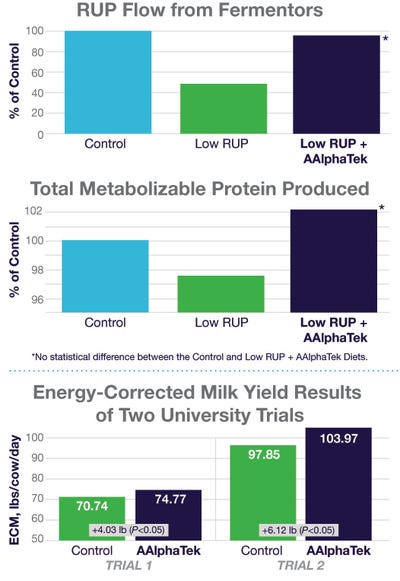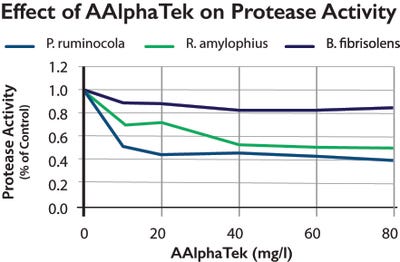Feeding the optimum amount of protein is a difficult balancing act.
October 15, 2019

Sponsored Content
How do you define cost-efficient milk production? Dairy producers and nutritionists may have different answers. They both, however, want the same outcome: maximized milk and milk components at the lowest possible ration cost.
When margins are tight, producers often pursue cost efficiencies by cutting ration cost. Nutritionists are then faced with the challenge of reducing cost while retaining milk production and components. It can be done, but it’s a delicate balance.
High-yielding dairy cows need to be fed the right mix of proteins to achieve this balance, which is dependent on two key factors. First, degradable protein (RDP) must be available to feed rumen bugs to create microbial protein. This must be balanced with, the second factor, the right amount of protein that doesn’t degrade (RUP) in the rumen so it can be made available as amino acids in the small intestine.
RUP helps to bridge what rumen bugs can’t achieve naturally in high-producing cows. Amino acids are vital to achieving the milk and milk component production producers seek.
A common method to balance proteins is to add blood meal to rations. It’s a good source of lysine, one of the ten essential amino acids needed for high milk production. The hope is that blood meal will escape the rumen and become available as a reliable source of amino acids in the cow’s small intestine.
But, as everyone knows, blood meal’s drawback is its inconsistency. Blood meal can vary widely in lysine levels, other amino acid availability, and palatability. This makes balancing a ration with blood meal misleading because we don’t know what the cow is actually taking in.
A consistent alternative to blood meal
Fortunately, you don’t have to rely only on blood meal to manage RUP. Instead, consider using a rumen modifier that shifts RDP to RUP. When you modify the ration’s lower-cost protein, RDP, to raise the level of the expensive protein source, RUP, you immediately get a reduction in ration cost (Fig. 1).
In short, you can feed a more economical rumen degradable source of protein rather than a high-cost undegradable source without giving up milk production or component quality (Fig. 1).

Fig. 1 – Research trials show AAlphaTek increases the level of rumen undegradable protein and microbial protein, leading to increased energy-corrected milk.
AAlphaTek is a research-based supplement for lactating dairy cows that reduces protein degradation in the rumen. It works by slowing the protease activity of specific rumen microbes, resulting in higher nitrogen efficiency and less rumen ammonia (Fig. 2). This allows more protein to escape the rumen as RUP and be digested in the small intestine, providing more amino acids to the cow.

Fig. 2 – By slowing protease activity, AAlphaTek allows more RUP to reach the small intestine.
Balancing protein and amino acids for lactating cows can be challenging. Overdo RUP or RDP, and you’ll be off balance. Cows could end up wasting protein through nitrogen excretion. Do it right, and you can optimize how you feed protein.
Use income over feed costs to measure results.
After altering the ration, monitor Income over Feed Cost (IOFC) to measure the return on investment. Avoid making a change that reduces feed costs and lowers milk production to the point of cancelling out feed savings.
Nutritionists can model AAlphaTek in their ration-balancing technology to understand how it will influence cow performance and the resulting financial impact to the dairy producer.
Advising a dairy is an ongoing balance between cutting costs and increasing profits. The ration is a balancing act. A rumen modifier can reduce protein degradation in the rumen, paving a smoother path to feeding an economical source of protein. Lower the ration cost, and maintain production with AAlphaTek.
About the Author(s)
You May Also Like


.png?width=300&auto=webp&quality=80&disable=upscale)
